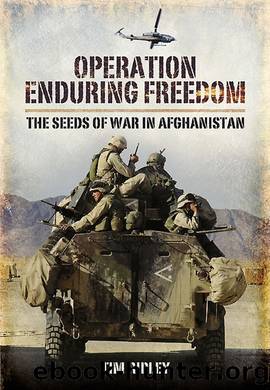Operation Enduring Freedom by Tim Ripley

Author:Tim Ripley
Language: eng
Format: epub
ISBN: 9781844686056
Publisher: Pen and Sword
Published: 2012-11-14T16:00:00+00:00
A USAF B-52H Stratofortress bomber sits on the parking ramp at Diego Garcia waiting for maintenance on 5 December 2001. (USAF/SSgt Shane Cuomo)
However, the commander of CENTCOM, General Tommy Franks, was not going to run the Afghan campaign in the way the no-fly zone mission was conducted and made two key changes to the way the CAOC worked. First, he drew back the power to decide on which specific targets would be attacked. In Operation Southern Watch, as the Iraq mission was code-named, CENTCOM issued general guidance to the CAOC on the campaign objectives and then left it to General Wald or his senior staff to select the ground targets to be bombed, as well as the number of aircraft and weapons to be used to destroy them. In Operation Enduring Freedom, CENTCOM in co-operation with the CIAâs Counter Terrorism Centre (CTC) worked out these details and informed the CAOC about the weight of effort required over the coming week and then specified the number of sorties and targets to be attacked over the coming twenty-four hours.
Further detailed control was exercised through very tight rules of engagement (ROE), which determined when US pilots could drop bombs or fire missiles at Afghan targets. The overriding need to avoid antagonizing the Afghan population and win them over from the Taliban cause meant that collateral damage and civilian casualties had to be avoided except in exceptional circumstances. Air attacks on any target that would cause significant civilian casualties or have a negative impact on Afghan opinion, such as mosques or public buildings, had to be personally approved by Franks and in some cases Defense Secretary Donald Rumsfeld or even President George Bush. For pre-planned air strikes this involved prior notification for approval but during attacks emerging or time sensitive targets (TST) a more complex procedure came into play. Pilots and FACs had to first notify the CAOC via the AWACS, or the CTC in the case of CIA operatives, if they wanted clearance to bomb a sensitive target. The request would then be flashed to Franks, or even higher up, for approval. Not surprisingly, this convoluted and time-consuming procedure was not popular with US pilots or senior officers in the CAOC and was a major divergence from the experience of Operation Southern Watch, where General Wald and the CAOC had the delegated authority to order air strikes if a series of specific criteria had been met. Some USAF air force officers involved in the Afghan campaign thought the new Afghan rules questioned their judgement and showed a lack of confidence in their professionalism.
Download
This site does not store any files on its server. We only index and link to content provided by other sites. Please contact the content providers to delete copyright contents if any and email us, we'll remove relevant links or contents immediately.
| Africa | Americas |
| Arctic & Antarctica | Asia |
| Australia & Oceania | Europe |
| Middle East | Russia |
| United States | World |
| Ancient Civilizations | Military |
| Historical Study & Educational Resources |
The Battle of Mogadishu by Matt Eversmann & Dan Schilling(723)
The Confidence Men by Margalit Fox(672)
The Spymaster of Baghdad by Margaret Coker(643)
A History of the Muslim World since 1260: The Making of a Global Community by Vernon O. Egger(642)
Jack the Ripper and the East End by Peter Ackroyd(611)
Empire of Fear: Inside the Islamic State by Andrew Hosken(589)
The Afghanistan File by Prince Turki AlFaisal Al Saud(586)
The Crimean War by Winfried Baumgart(579)
Islam At The Gates: How Christendom Defeated the Ottoman Turks by Diane Moczar(574)
The Jerusalem Diamond by Noah Gordon(568)
Akhenaten by Dominic Montserrat(566)
A Concise History of Greece (Cambridge Concise Histories) by Richard Clogg(556)
Beirut 2020 by Charif Majdalani(555)
The History of Jihad by Robert Spencer(550)
Enemy in the East by Rolf-Dieter Müller(536)
Israel: Ancient Kingdom or Late Invention? by Daniel I. Block(532)
The Privatization of Israeli Security by Shir Hever(527)
The Nine Lives of Pakistan by Declan WALSH(522)
Destroying a Nation: The Civil War in Syria by Nikolaos van Dam(516)
